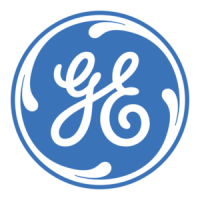
Do you have a question about the GE GG75T06ASK and is the answer not in the manual?
| Brand | GE |
|---|---|
| Model | GG75T06ASK |
| Category | Water Heater |
| Language | English |
Identifies the water heater models and outlines the scope and purpose of the manual.
Highlights critical safety alerts including mobile home suitability, Prop 65, and gas leak response protocols.
Details severe risks from incorrect draft hood installation and venting to prevent carbon monoxide.
Warns about the extreme danger of flammable liquids and vapors near the water heater.
Explains the risk of severe burns or death from water over 125°F, referencing the scald chart.
Advises on setting temperatures, especially for vulnerable individuals, and suggests mixing valves.
Discusses differences between gas types, conversion prohibition, and LP gas properties.
Outlines procedures for detecting gas leaks and the immediate actions to take.
Emphasizes following manual information for safety and lists general precautions.
Details California's legal mandates for bracing water heaters against earthquakes.
Covers ideal placement, protection from damage, flammable liquids, and garage installation specifics.
Specifies required clearances from combustible surfaces and rules for floor installation.
Addresses installation constraints for confined spaces and limits on flexible connectors.
Advises on checking for shipping damage and confirming the correct gas type.
Explains air supply needs for confined spaces, unconfined spaces, and ducting.
Warns about corrosive environments and their effect on the warranty.
Explains thermal expansion and the use of expansion tanks to manage pressure.
Recommends unions, shut-off valves, and connection types for ease of servicing.
Details requirements for the temperature and pressure relief valve and its discharge piping.
Guides on filling the tank and explains the phenomenon of initial condensation.
Covers gas line material, unions, shut-off valves, leak testing, and compounds.
Addresses pressure testing requirements and input reductions for high altitudes.
Highlights severe risks associated with incorrect venting and draft hood installation.
Specifies requirements for vent connectors, pitch, and clearances from combustibles.
Provides cautions for installing external insulation blankets to maintain proper function.
Guides on installing pipe insulation for improved energy efficiency.
Explains the purpose and installation of factory-installed heat traps.
Checklist items ensuring proper location, clearances, and air supply.
Checklist items for verifying water and gas supply connections.
Checklist items for confirming correct installation of relief valve and venting.
Instructions for integrating the water heater for domestic hot water and space heating.
Crucial warnings about mixing valves and potential contamination from toxic chemicals.
Explains the provided diagram illustrating plumbing for combined applications.
Emphasizes crucial safety steps before attempting to light the pilot, including gas smell checks.
Provides detailed instructions for lighting the pilot light using the gas cock knob and red button.
Explains how to safely turn off the gas to the appliance.
Highlights safety considerations specific to alternative pilot lighting methods.
Details the procedure for lighting the pilot using a piezo ignitor, including visual checks.
Advises on the potential for hydrogen gas formation in unused systems and precautions.
Covers essential safety measures during operation, such as turning off gas and preventing fires.
Identifies and explains the function of key water heater parts through a diagram.
Explains adjustments for the burner's flame and the thermostatic gas valve.
Details how to set water temperature and the importance of scald prevention.
Explains how to check and set the desired water temperature using the dial.
Describes the phenomenon of water stacking and its potential effects on temperature.
Reiterates safety precautions for using hot water, especially concerning children and incapacitated individuals.
Provides instructions and safety warnings for safely draining the water heater tank.
Recommends establishing a regular maintenance schedule for optimal performance.
Advises on keeping the area around the heater clean and maintaining required ventilation clearances.
Details the annual inspection process for the venting system and flue baffle.
Explains how to inspect and clean the main and pilot burners.
Guides on preparing the water heater for periods of inactivity to prevent issues like hydrogen gas.
Explains the anode rod's role in tank protection and its necessary maintenance.
Addresses common causes and solutions for condensation on the water heater.
Covers issues related to improper flame color, sooting, and restricted air inlets.
Provides steps for fixing pilot lighting failures and pilot outage problems.
Explains causes for rumbling and rattling noises related to sediment or heat traps.
Covers common reasons for lack of hot water, such as water usage or low gas pressure.
Addresses issues with water being too hot or too cold, relating to thermostat settings.
Provides instructions on placing an order for specific parts, including required information.
Illustrates and labels various component parts of the water heater for identification.
Advises contacting installers or local service agencies first for assistance.
Details the information needed when contacting the manufacturer's service department.
Outlines the three key steps for registering the product to ensure protection.
Refers to the specific information required on the registration card for completion.
